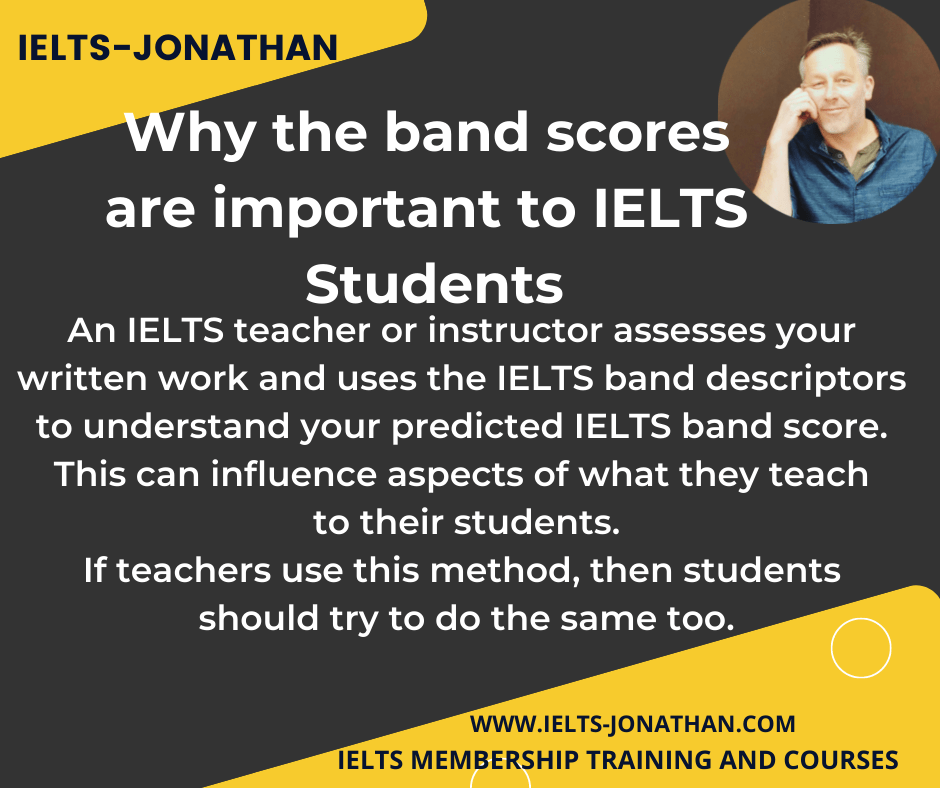The importance of understanding IELTS Task 2 Band Scores
Being able to understand and interpret the IELTS band scores for Task 2 should be a part of any student’s IELTS Preparation.
Why the band scores are important to IELTS Students
The band scores not only allow the IELTS examiner to assess your final writing score, but can also be used to broadly improve student writing.
How the band scores are useful to teachers
A good teacher will assess your written work and use the IELTS band descriptors to work out your predicted IELTS band score.
This then can influence aspects of what they teach to their students.
If the band scores are useful to teachers, then they have to be valuable to students.
If teachers use this method, then one good way that you can work to improve your own writing score is to use the IELTS Band Scores as a guide and grade what you are presently doing rightly or wrongly.
Or to put it another way, if you do not know what you assessment is based on, how can you aim to improve or even get that score you need,
writing-band-descriptors-task-2
Public Descriptors from IELTS.org
How to read the IELTS Band Scores and Descriptors
It is easy to read and understand how the band scores work in principal.
As you can see there are four vertical columns and in each column there are nine rows which correspond to a band score number.
In each of the rows there are ‘descriptors‘ which describe if something exists.
Addresses the task only partially; the format may be inappropriate in places at Band 5 Public Descriptors Task 2
or grades the existence of the statement.
Uses less common lexical items with some awareness of style and collocation at Band 7 Public descriptors Task 2
A number is selected for each column that matches the examiner’s assessment of your writing and the total grade is divided by 4 which can result in a full band score for example, Band Score 7, or a half band score like 7.5.
What the IELTS Task 2 Band Scores really mean
There are certain ‘sentences contained in the band score’ that send a big signal to examiners and these are often the aspects that are looked for in your writing first.
‘expresses a position but the development is not always clear and there may be no conclusions drawn’ at Band 5
In this example, not having an obvious conclusion means that you cannot go higher than Band 5 as the writing does not include ‘a conclusion’.
This also means that at Band 6 a conclusion ‘may be unclear’ and for a student to achieve Band 7,
a conclusion should ‘present a clear position throughout’
or ‘in my words’, the essay and conclusion should ‘be clear and represent the whole essay position throughout’.
writing-band-descriptors-task-2
1 – Task Response
For Task 2 there is no difference between the IELTS Academic test and the IELTS General test.
Task Response refers to how well you have responded to the proposition (the argument) and to the prompts (the task) and this section can be divided into skills and subskills.
To respond to a task completely, you need ‘an essay introduction’, ‘an essay conclusion’ and ‘body paragraphs’ that satisfy the prompts of the question.
For example, if the prompt asks for ‘a discussion of the advantages and disadvantages of the proposition’, then two body paragraphs would be needed to satisfy the prompts.
Similarly, if the prompt asks for ‘the causes’ and ‘the solutions’ then two body paragraphs are required to meet Band 6 of this band descriptor.
Likewise, a question that merely asks for you opinion, as in this question:
Many old buildings protected by law are part of a nation’s history. Some people think they should be knocked down and replaced by news ones.
How important is it to maintain old buildings?
may require only one body paragraph to satisfy the Band 6 TR score but a balanced ‘opinion’ essay is usually better dealt with by two main body paragraphs.
At Band 6 this means;
- addresses all parts of the task although some parts may be more fully covered than others
- presents a relevant position although the conclusions may become unclear or repetitive
- presents relevant main ideas but some may be inadequately developed/unclear
At Band 7 the means;
- addresses all parts of the task
- presents a clear position throughout the response
- presents, extends and supports main ideas, but there may be a tendency to over-generalise and/or supporting ideas may lack focus
What a BAND 7+ score looks like
In the Academic Writing Task, make sure you have a clear introduction, body paragraphs that answer the question prompts and a strong conclusion that is relevant and supports the information in the other essay paragraphs.
2 – Coherence and Cohesion
-At Band 6 this means;
- arranges information and ideas coherently and there is a clear overall progression
- uses cohesive devices effectively, but cohesion within and/or between sentences may be faulty or mechanical
- may not always use referencing clearly or appropriately
- uses paragraphing, but not always logically
At Band 7 this means;
- logically organises information and ideas; there is clear overall progression throughout
- uses a range of cohesive devices appropriately although there may be some under-/over-use
- presents a clear central topic within each paragraph
What a BAND 7+ score looks like
In your writing, make sure that paragraphs are used and arranged logically, and sentences (and the information contained in the paragraphs) within paragraphs are focussed and arranged to create an easy to read text ‘that flows’.
Make sure the reader is assisted by appropriate linking and referencing words, even if there might be some errors in their use.
3 – Lexical Resource
At Band 6 this means:
- uses an adequate range of vocabulary for the task
- attempts to use less common vocabulary but with some inaccuracy
- makes some errors in spelling and/or word formation, but they do not impede communication
At Band 7 this means:
- uses a sufficient range of vocabulary to allow some flexibility and precision
- uses less common vocabulary but with some awareness of style and collocation
- may produce occasional errors in word choice, spelling and/or word formation
What a BAND 7+ score looks like
A good writer at this level will naturally display enough vocabulary and a variety that avoids repetition and indicates your level and awareness of the English Language.
There can be a few errors or mistakes as long as these do not alter the message you are communicating, so check the meaning, that it is appropriate and check the spelling.
4 – Grammatical Range and Accuracy
At Band 6 this means:
- uses a mix of simple and complex sentence forms
- makes some errors in grammar and punctuation but they rarely reduce communication
At Band 7 this means;
- uses a variety of complex structures
- produces frequent error-free sentences
- has good control of grammar and punctuation but may make a few errors
What a BAND 7+ score looks like
Similarly to ‘lexical resource’, a good writer will naturally display enough complex grammar structures and grammatical forms that help the reader.
These structures do not mean ‘long and complicated sentences’ but simply grammar that ‘helps explain complex ideas’.
Grammatical items that may be noticed by the examiner can include countability, modality, passive sentences, use of tense, pre and post-modifying phrases and nominalisation, as well as the use of clauses.
What is important to note is that any grammatical items used will be produced accurately and for the purpose of communicating a message and not be forced.
Finally, the 250 words or so of writing should be free of punctuation errors, so make sure you have checked for capital letters, commas and full-stops.
Conclusion and final points about using the IELTS Band Scores
Using the IELTS band scores as a guide to your current level can be a good way to focus on areas to improve.
However, it is often difficult to be objective about our own current abilities and sometimes we need the objective/subjective opinion of a teacher or an IELTS Expert especially with gradable statements.
Of course, gradable statements mean you need to improve or work at focusing on these weaknesses, if you have any.
However, as part of your IELTS preparation, having a good understanding of the marking criteria means you are already one step ahead in getting the IELTS score you need. 🙂
Researched using the IELTS Public Band Descriptors 2022



Was this helpful? Leave a comment :)